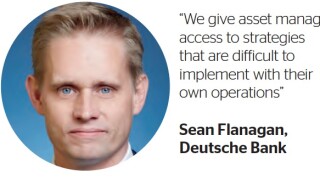Top Section/Ad
Top Section/Ad
Most recent
JP Morgan and Dutch pension fund PGGM transacted derivatives margin trade
◆ Chinese bank treasury shift from USTs to dollar callables considered ◆ Some European SSAs face cross-currency limitations ◆ Previous market staple 'almost non-existent'
Bank intermediaries eye resurgence in profitable trades
More articles/Ad
More articles/Ad
More articles
-
After much heated debate, the Derivatives Service Bureau (DSB), which generates international securities identification numbers for some over the counter derivatives, seems to have successfully navigated the first week of the Markets in Financial Instruments Directive’s second coming.
-
IHS Markit on Wednesday announced that Lord Browne of Madingley and Nicoletta Giadrossi have joined as board directors of the company, while its president and COO Lance Uggla became CEO on January 1.
-
Deal-contingent products — flexible derivatives for hedging the FX risk of cross-border acquisitions — are moving from the private equity industry to other markets. Infrastructure is considered a prime fit for the tool. But tricky accounting standards and incoming regulation could complicate the instruments’ roll-out to new users, writes Ross Lancaster.
-
With yields compressed and equity volatility at a historically low level, hunting for consistent returns has been a challenge for asset managers and institutional investors alike. But as Costas Mourselas reports, the meteoric rise of risk premia strategy, a type of passive investing, promises to at least partially alleviate those woes.
-
Five years after being pushed on to trading venues in the US by the Dodd-Frank Act, over-the-counter derivatives players are beating a similar path in Europe, under the Markets in Financial Instruments Directive II. Most people think MiFID II has been a worse experience, and will make it harder for small players. But efficiency gains may follow. Ross Lancaster reports.
-
It is six months since Andrew Bailey, head of the UK financial regulator, set the clock ticking on a transition from the London interbank offered rate to an alternative. But if credible replacements are to be ready by his 2021 deadline, there is still a mountain of work to do. Ross Lancaster explores the risks of phasing out the old benchmark and asks if it could yet survive.











